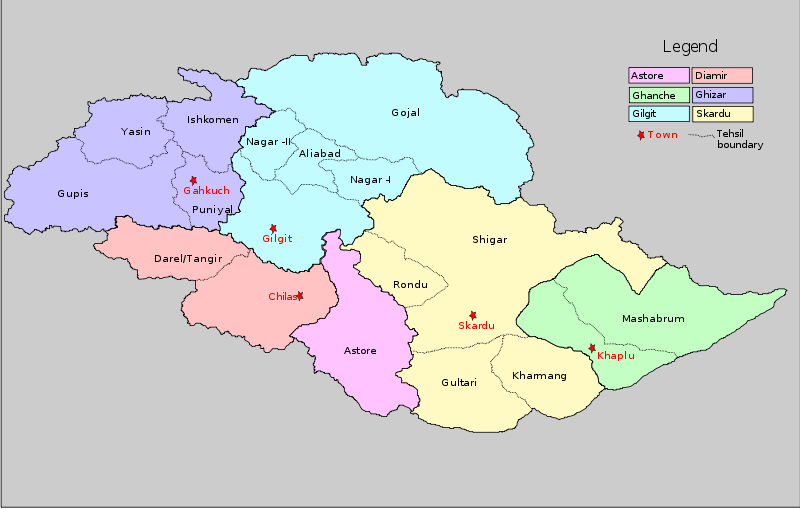 History
History:
Gilgit–Baltistan was part of the Delhi Sultanate until it fell to the Mughal Empire in the early half of the 16th century. The territory became predominantly Muslim during the rule of the Delhi Sultanate and later the Mughal Empire due to missionary Sufi saints whose digraphs dot the landscape. By 1757, suzerainty of the region was obtained from the Mughals by Ahmad Shah Durrani under an agreement and became part of Afghanistan (also known as the Durrani Empire) until Ranjit Singh invaded and took control from the Afghans in 1819. It became a princely state with the name "Jammu and Kashmir" around 1846. After Pakistan achieved independence in 1947, Jammu and Kashmir also initially remained an independent state. On 22 October 1947 the Pakistani armed forces crossed the border in Jammu and Kashmir with the claim that they needed to suppress a rebellion on the southeast of the kingdom. Local tribal militias and the Pakistani forces moved to take Srinagar but on reaching Uri they encountered defensive forces. Hari Singh made a plea to India for assistance and signed the Instrument of Accession. The British government also took part in stopping the Pakistani forces from advancing. On January 20 1948 the UN passed a resolution which called for the withdrawal of all Pakistani forces from Jammu and Kashmir, however it has remained under the control of Pakistan since then. In 1970 the two part territory was merged into a single administrative unit, and given the name the name "Northern Areas". The name "Northern Areas" was actually first used by the United Nations to refer to the northern areas of Kashmir.[citation needed] The Shaksgam tract, was ceded by Pakistan to China following the signing of the Sino-Pakistani Frontier Agreement in 1963.
Before the demise of Shribadat, the last Hindu king of the Trakhan dynasty in Gilgit, a group of Shin people migrated from Gilgit Dardistan and settled in the Dras and Kharmang areas. The descendants of those Dardic people can be still found today, and is believed that they have maintained their Dardic culture and Shina language up to the present time.
Government
The territory of present-day Gilgit–Baltistan became a separate administrative unit in 1970 under the name "Northern Areas." It was formed by the amalgamation of the former Gilgit Agency, the Baltistan District of the Ladakh Wazarat, and the hill states of Hunza
and Nagar. It presently consists of nine districts, has a population approaching one million, an area of approximately 28,000 square miles (73,000 km2), and shares borders with Pakistan, China, Afghanistan, and India. In 1993, an attempt was made by the High Court of Azad Jammu and Kashmir to annex Gilgit–Baltistan but was quashed by the Supreme Court of Pakistan after protests by the predominantly Shia population of Gilgit–Baltistan, who feared domination by the Sunni Kashmiris.
While administratively controlled by Pakistan since the first Kashmir war, Gilgit–Baltistan has never been formally integrated into the Pakistani state and does not participate in Pakistan's constitutional political affairs. On August 29, 2009, the Gilgit–Baltistan Empowerment and Self-Governance Order 2009, was passed by the Pakistani cabinet and later signed by the President of Pakistan. The order granted self-rule to the people of Gilgit–Baltistan, by creating, among other things, an elected Gilgit-Baltistan Legislative Assembly and Gilgit-Baltistan Council. Gilgit–Baltistan thus gained de facto province-like status without constitutionally becoming part of Pakistan. Officially, Pakistan has rejected Gilgit–Baltistani calls for integration with Pakistan on the grounds that it would prejudice its international obligations with regard to the Kashmir dispute. Some militant Kashmiri nationalist groups, such as the Jammu and Kashmir Liberation Front, claim Gilgit–Baltistan as part of a future independent state to match what existed in 1947. India, on the other hand, maintains that Gilgit–Baltistan is a part of the Indian state of Jammu and Kashmir. Because of human rights violations in the region, political parties in India have sought government intervention there.
On September 29, 2009, the Pakistani prime minister, while addressing a huge gathering in Gilgit–Baltistan, announced a multi-billion-rupee development package aimed at the socio-economic uplifting of the people of the area. Development projects are slated to include the areas of education, health, agriculture, tourism, and the basic needs of life.

